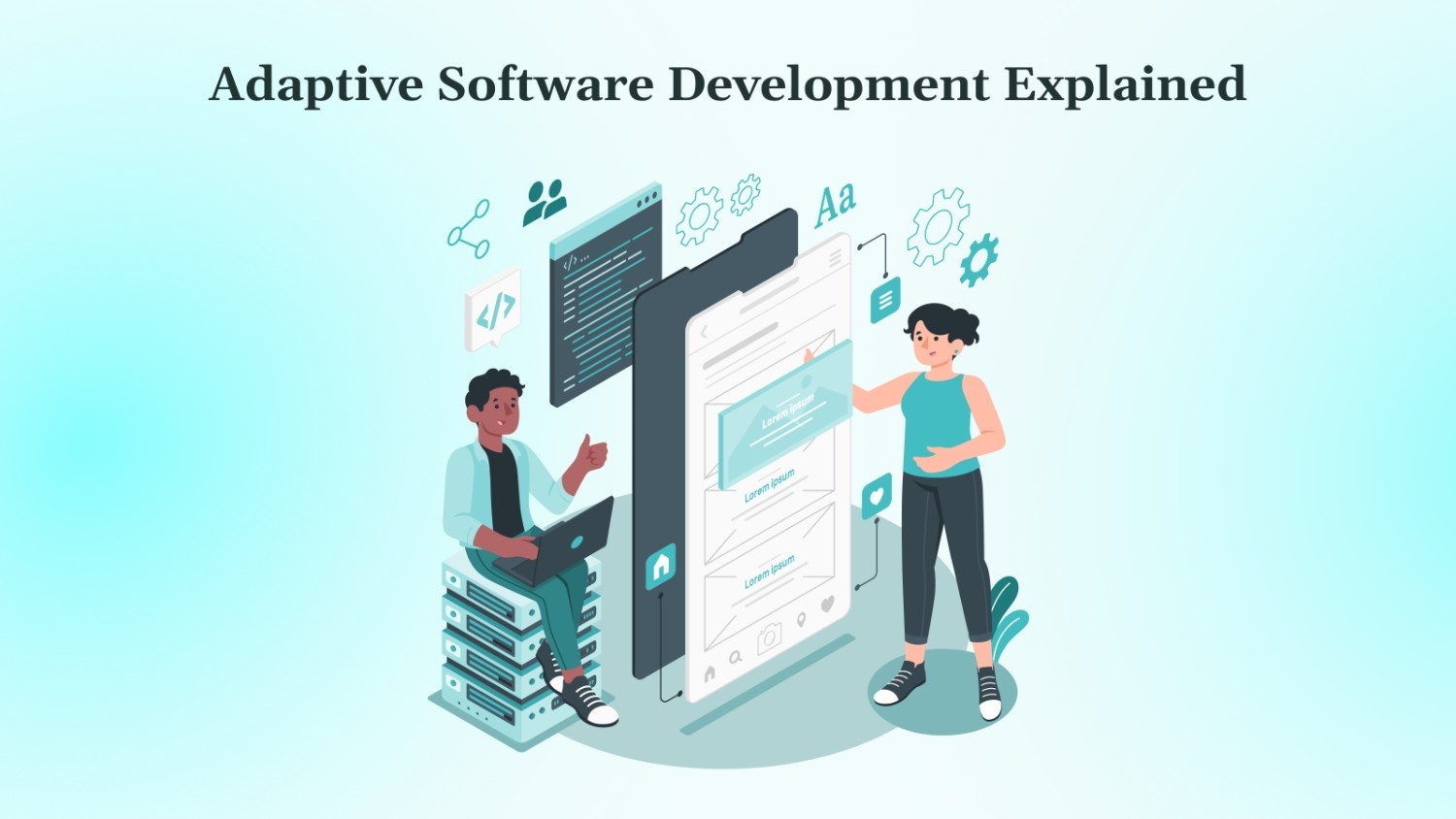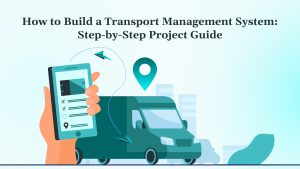In software development, projects often move faster than teams can handle. Traditional methods, with rigid plans and fixed requirements, struggle to adapt to changing customer requirements and market shifts.
That is why 68% of businesses have already adopted agile methods for greater flexibility. Adaptive Software Development (ASD) builds on this approach, going further to embrace change and prioritize continuous feedback.
By delivering software in stages and responding quickly to new demands, ASD helps teams innovate while keeping projects aligned with business goals. In this blog, you will explore the core principles of ASD, how it works, and why more businesses are choosing it to stay competitive in a fast-changing environment.
Key Takeaways:
- Adaptive Software Development (ASD) enables teams to build software that evolves with changing requirements, emphasizing flexibility, collaboration, and iterative delivery.
- It is ideal for industries like FinTech, HealthTech, SaaS, and other fast-changing sectors where requirements are unclear or evolving.
- Teams work in cycles of Speculate, Collaborate, and Learn, delivering functional software incrementally while incorporating continuous feedback.
- Key benefits include faster time-to-market, user-centric products, improved risk management, and continuous process improvement.
- ASD strategies reduce scope creep, enhance team alignment, and ensure high-quality outcomes despite changing project demands.
What is Adaptive Software Development?
Adaptive Software Development (ASD) is an agile approach that emphasizes flexibility, collaboration, and continuous learning. Instead of following a rigid plan, ASD allows teams to respond to changing requirements throughout the development process.
It supports iterative software evolution, incorporating frequent feedback and adjustments to meet both project and user needs. Unlike traditional step-by-step models, ASD encourages teams to improve the software as they go, delivering functional components incrementally.
For example, Payvantage, a fintech startup, utilized ASD to overcome challenges with legacy systems and scaling infrastructure.
With iterative development, Payvantage reduced application processing time from 15 minutes to just 5 minutes while cutting abandonment rates by 40%. This incremental progress allowed them to deliver a faster and more user-friendly platform.
By enabling step-by-step improvements and continuous feedback, ASD helps teams deliver solutions that align closely with business needs and user expectations. Strong collaboration between developers, stakeholders, and end-users ensures the final product meets everyone’s requirements.
While collaboration drives ASD today, its roots lie in how the methodology first emerged and evolved over time.
History of Adaptive Software Development
Adaptive Software Development (ASD) emerged in the 1990s as a response to the limitations of traditional methodologies like the Waterfall Model and Structured Development.
These conventional approaches often struggled to keep up with changing business needs and technology, leading to delays, misaligned user expectations, and rigid project plans. Here is how it evolved:
Origins and Early Influences
By the late 20th century, the need for a more flexible approach to software development became clear. Pioneers like Jim Highsmith and Sam Bayer explored alternatives to rigid models. Highsmith, in particular, drew inspiration from earlier approaches:
- Rapid Application Development (RAD, 1980s): Focused on quick prototyping and user feedback, offering more flexibility than Waterfall while maintaining some structure.
- Spiral Development (late 1980s, Barry Boehm): Emphasized iterative refinement through risk analysis, but lacked the full adaptability that ASD later introduced.
Birth of Adaptive Software Development
In the mid-1990s, Jim Highsmith introduced ASD, treating software development as an adaptive, evolving process rather than a linear one. In 1999, he published Adaptive Software Development: A Collaborative Approach to Managing Complex Systems, highlighting the core principles of ASD:
- Embracing change
- Facilitating collaboration
- Delivering working software incrementally.
Connection to Agile Methodology
ASD shares many principles with the Agile Manifesto (2001), such as iterative development, constant feedback, and close collaboration between teams and stakeholders.
While Agile defines specific practices, ASD provides a broader framework focused on adaptability, speed, and responsiveness.
Evolution and Adoption
ASD has evolved alongside methodologies like Scrum and Extreme Programming (XP). Its focus on continuous adaptation makes it ideal for projects with unclear or rapidly changing requirements.
Industries such as FinTech, HealthTech, and SaaS often adopt ASD to meet digital demands. The flexibility allows businesses to respond promptly to market trends and customer feedback, producing products that better align with user needs.
While the flexibility makes ASD appealing across sectors, it is important to weigh both the strengths and potential drawbacks.
Strengths & Weaknesses of Adaptive Software Development
Adaptive Software Development (ASD) is valued for its flexibility and collaborative approach, but like any methodology, it comes with both strengths and weaknesses. Knowing these can help businesses decide when and how to use ASD effectively, maximizing its benefits while managing potential challenges.
Strengths of ASD
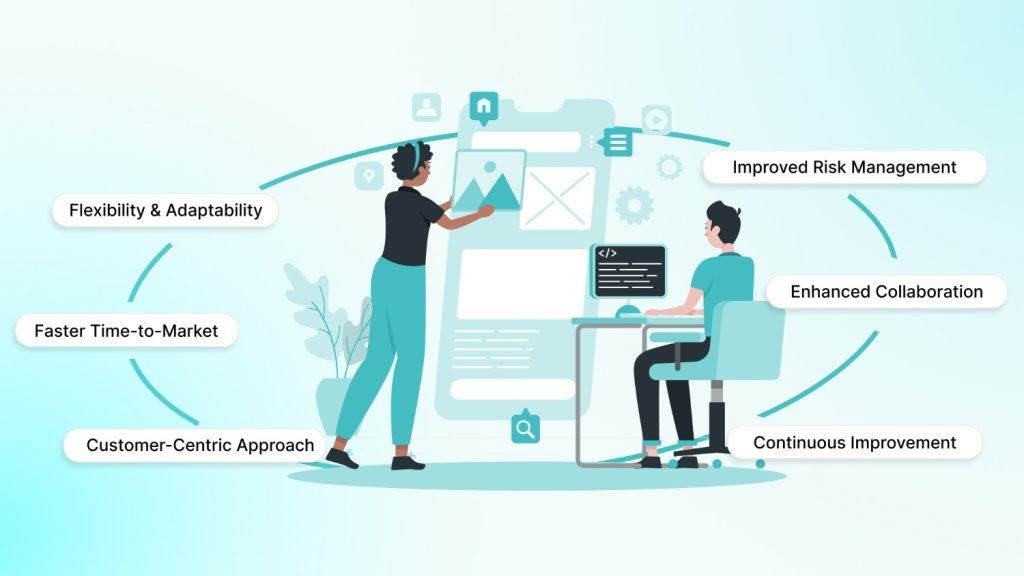
Here are some key strengths of Adaptive Software Development (ASD):
- Flexibility and Adaptability: ASD allows continuous refinement based on changing requirements and feedback, ensuring the software evolves to meet both business and user needs.
- Faster Time-to-Market: Its iterative approach delivers functional software in increments, enabling early releases, user feedback, and faster responses to market demands.
- Customer-Centric Approach: Frequent stakeholder collaboration and feedback ensure the product aligns with user expectations, boosting satisfaction and market relevance.
- Improved Risk Management: Iterative cycles help identify and address risks early, reducing project failure and keeping the software aligned with evolving requirements.
- Enhanced Collaboration: Constant interaction among developers, stakeholders, and users encourages alignment, teamwork, and a more engaged development process.
- Continuous Improvement: Ongoing evaluation and refinement enable teams to improve processes and deliver products that evolve with user needs.
One of the biggest strengths of Adaptive Software Development (ASD) is its flexibility in handling changes. Take Moveit4U, a transport management system built by DEVtrust, as an example. The team used ASD to respond quickly to shifting logistics needs.
Through regular iterations and continuous feedback, they cut administrative work by 50%, improved overall efficiency, and enabled real-time updates for delivery routes and job scheduling.
Weaknesses of ASD
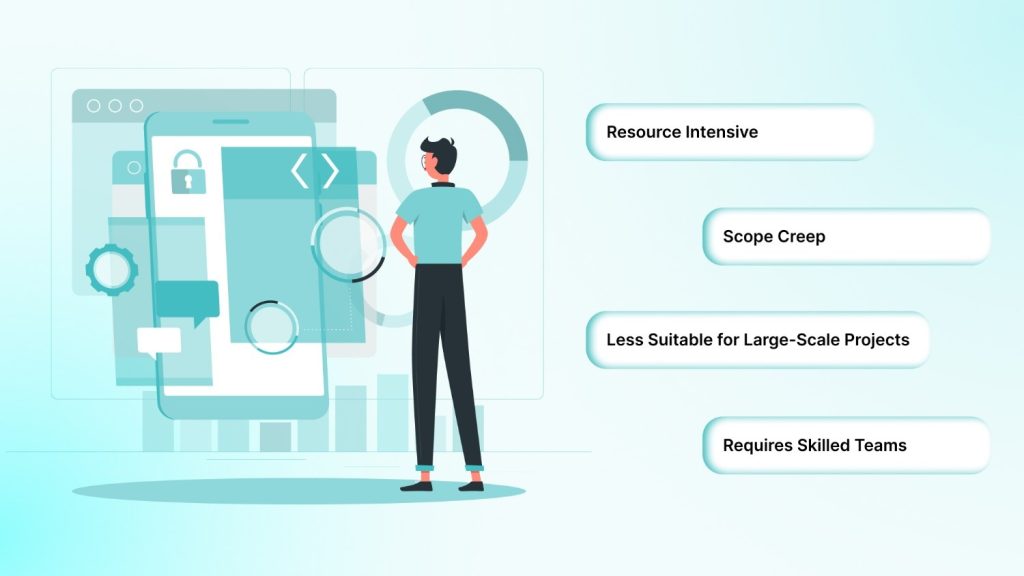
Here are some key weaknesses of Adaptive Software Development (ASD):
- Resource Intensive: Continuous feedback, frequent iterations, and ongoing collaboration can be time-consuming, often requiring dedicated teams and increasing operational costs.
- Scope Creep: Emphasis on adaptability may expand the project beyond its original plan if feedback and changes are not carefully managed, causing delays and higher costs.
- Less Suitable for Large-Scale Projects: For complex projects with many dependencies, ASD may be less efficient than structured approaches like Waterfall.
- Requires Skilled Teams: ASD relies on experienced, adaptable teams. Inexperienced teams may struggle with rapid changes and collaborative decision-making, risking quality and deadlines.
Implementing ASD involves several steps, and having the right guidance makes all the difference. At DEVtrust, we provide consultation and development support to help you manage challenges such as scope creep and resource planning.
Our team works with you to build flexible, scalable software solutions tailored to your business requirements. Reach out to us today to explore how we can support your next project.
Evaluating strengths and weaknesses naturally leads to a closer look at the defining characteristics of Adaptive Software Development.
Characteristics of Adaptive Software Development
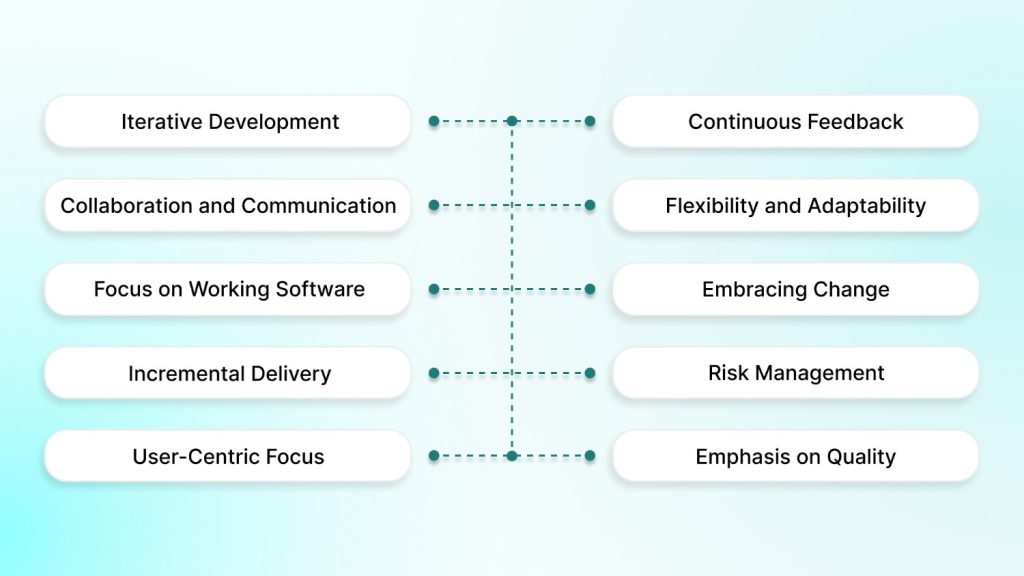
Adaptive Software Development (ASD) is defined by its ability to adjust and evolve with changing project requirements. It allows teams to respond promptly to change, deliver value faster, and ensure the final product meets real user needs. The following key characteristics define this methodology:
Iterative Development
Adaptive Software Development (ASD) is all about taking things step by step. Instead of locking in a fixed plan from the start, work is divided into smaller cycles called iterations.
Each iteration provides a functional version of the software that can be tested, reviewed, and refined. This process allows teams to adapt quickly to feedback, ensuring continuous improvement as the product evolves.
Continuous Feedback
Feedback is key in ASD. After every iteration, input from stakeholders, including customers and end-users, is gathered to ensure the software meets expectations and business goals.
A great example of continuous feedback at work is SpaceComps, a real estate platform built by DEVtrust. Using iterative development, the team rolled out features such as user-driven deal proposals and a credit-based information access system.
These updates drove a 40% rise in deal submissions and a 30% increase in user engagement, showing how continuous feedback can create real, impactful improvements.
This shows how the flexibility of ASD helps deliver high-quality, user-focused products that evolve with customer needs.
Collaboration and Communication
ASD grows on teamwork. Developers, stakeholders, and customers work closely together rather than in isolation. Regular communication keeps everyone aligned, building trust and ensuring the product develops in line with business needs.
Flexibility and Adaptability
One of the biggest strengths of ASD is its ability to adapt. Unlike traditional models with rigid plans, ASD allows changes at any stage of development.
This makes it easier to respond to market shifts, new technologies, or evolving customer needs, refining the product as new information becomes available.
Focus on Working Software
The priority in ASD is delivering functional software rather than getting stuck in extensive planning or documentation. Each iteration results in a working product that stakeholders can review and provide feedback on.
This leads to faster releases and real-world testing early in the process, helping teams make informed decisions quickly.
Embracing Change
Change is seen as an opportunity in ASD, not a setback. Adjustments are part of the process, helping improve the product and better meet user needs. This mindset makes ASD ideal for projects where requirements are likely to evolve or where innovation is essential.
Incremental Delivery
ASD promotes building software in small, manageable pieces. Each increment represents a part of the final product that can be tested and refined. This method allows faster delivery, shows clear progress, and ensures the product evolves in the right direction with every cycle.
Risk Management
By developing software in small steps, ASD helps identify and address risks early. Frequent reviews, testing, and feedback catch potential issues before they escalate, reducing the chance of project failure. Early risk management allows teams to make better decisions and avoid major disruptions.
User-Centric Focus
ASD keeps users at the center of development. Regular involvement from end-users ensures the software aligns with their needs and expectations. This results in products that are intuitive, practical, and relevant to the people who use them.
Emphasis on Quality
Even with its focus on speed and flexibility, ASD does not compromise on quality. Each iteration is tested thoroughly, and quality assurance is embedded throughout the process. Continuous testing ensures stability and addresses issues as they appear, rather than leaving them for the end of the project.
While ongoing testing improves stability, the bigger picture lies in understanding the entire Adaptive Software Development lifecycle.
Also Read: Understanding Software Development Processes and Practices
The Adaptive Software Development Lifecycle
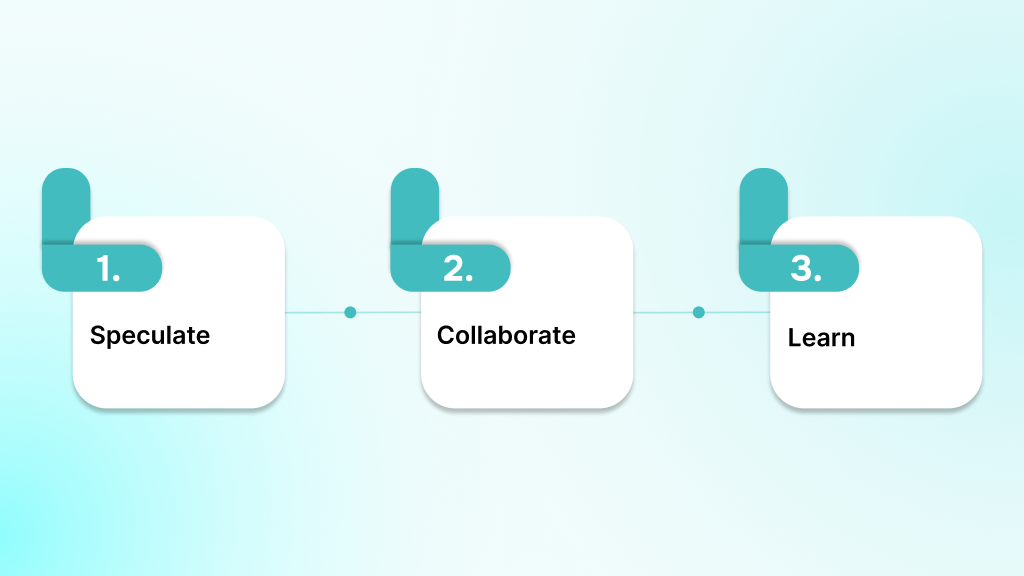
The Adaptive Software Development (ASD) lifecycle is built to be flexible, iterative, and responsive to change. It embraces ongoing adjustments and delivers working software in small, manageable increments.
The lifecycle consists of three main phases: Speculate, Collaborate, and Learn. These phases are repeated in cycles, allowing the software to evolve continuously based on user feedback, market needs, and business priorities.
1. Speculate
The Speculate phase is the beginning point of the ASD lifecycle. Here, the focus is on planning and sketching out the initial vision for the software, but with a key difference: the plan is flexible and can change.
The goal is not to create a rigid roadmap, but to set a direction and make educated guesses about what the final product might look like. This phase typically involves:
- Initial Planning: The team defines the core goals of the project and outlines the overall scope, knowing that it will likely evolve as the project moves forward.
- Risk Assessment: Potential risks and uncertainties are identified early so they can be managed effectively throughout the project.
- High-Level Design: A preliminary architecture and design are put in place, with the understanding that these may be adjusted based on feedback during iterative cycles.
- Setting Milestones: Broad milestones are established, but they remain flexible to adapt as new insights emerge.
The Speculate phase allows teams to make informed guesses about the software’s direction while staying open to change.
2. Collaborate
Once the initial vision is in place, the Collaborate phase is where most of the development work happens. In this phase, the team, stakeholders, and end-users work together continuously to build and refine the software. Key activities include:
- Continuous Communication: Regular interaction between developers, stakeholders, and customers ensures the project stays aligned with evolving needs and expectations.
- Incremental Development: The software is built in small, manageable chunks that are tested, reviewed, and improved throughout the process.
- Feedback Loops: Insights from users and stakeholders are collected regularly, guiding the next iteration of the product.
- Cross-Functional Teams: Collaboration involves not only developers, but also testers, designers, and business representatives, ensuring all perspectives are considered during each iteration.
This phase encourages flexibility, helping the team incorporate changes quickly and keep the product aligned with evolving requirements.
3. Learn
The Learn phase is about reflecting on the previous cycle and adjusting based on what the team has discovered. This phase is critical for ensuring the product evolves with real-world feedback and performance insights. Important elements of this phase include:
- Review and Retrospectives: The team examines the work done during the previous iteration, identifying both successes and areas for improvement. This reflection helps refine the approach for future cycles.
- Testing and Validation: Software is thoroughly tested to uncover bugs and assess performance in real-world conditions. User testing ensures the product meets expectations and requirements.
- Adaptation: Feedback and insights are used to adjust the product, the development process, or even the project’s overall direction. The adaptive nature of ASD allows the team to pivot or modify their approach as needed.
- Documentation and Knowledge Sharing: While formal documentation is minimized compared to traditional methods, key findings, code changes, and lessons learned are recorded to support future iterations.
The Learn phase keeps the product relevant and aligned with business goals and user needs, allowing the team to continuously refine the solution based on ongoing learning.
After completing a cycle, the team reviews the feedback and returns to the Speculate phase to reassess priorities, make any necessary adjustments, and keep building.
This cycle repeats as many times as needed, with each iteration bringing incremental improvements until the product reaches its final version.
Need Guidance in implementing the Adaptive Software Development lifecycle?
DEVtrust specializes in guiding businesses through the Speculate, Collaborate, Learn process, ensuring that your project adapts to changing requirements and evolves based on continuous feedback.
Contact us today to discuss your project and start building software that grows with your business needs.
While the cyclical process of ASD drives continuous improvement, it is important to see how this approach differs from other methodologies.
Adaptive Software Development vs. Other Methodologies
Adaptive Software Development (ASD) follows many of the same principles as other agile methodologies, but it stands out in how it handles flexibility, iteration, and collaboration.
Comparing ASD with other commonly used software development approaches can help determine when it is the right choice for a project. Below is a comparison of ASD with these other methodologies.
| Methods | Basic Principles | Major Features | Best for |
| Adaptive Software Development (ASD) | Iterative, flexible, and adaptive to changing requirements and feedback. | Speculate, Collaborate, Learn processContinuous feedback from stakeholdersFocus on collaboration and adaptability | Projects with evolving or unclear requirements, high uncertainty, or frequent changes in scope. |
| Dynamic Systems Development Method (DSDM) | Focuses on delivering business solutions with user involvement and strict timeframes. | Prioritizes user needsTimeboxingFrequent user feedback and iterative development | Projects with well-defined business goals but limited timeframes or budgets. |
| Waterfall | A linear, step-by-step approach where each phase depends on the previous one. | Rigid structureFixed requirementsSequential phases (Design, Development, Testing) | Projects with well-defined and stable requirements that are unlikely to change. |
| Scrum | A framework within Agile that focuses on iterative development in fixed-length sprints. | Sprint-based developmentClear roles (Scrum Master, Product Owner, Development Team)Daily stand-ups | Projects needing regular delivery of working software with close collaboration and time-boxed sprints. |
| Kanban | Focuses on continuous delivery without fixed iterations, using a visual workflow. | Continuous deliveryVisual boards for managing tasksFlexibility in work prioritization | Ongoing projects that need flexibility and continuous improvements with fewer formalities. |
| Agile | A set of principles advocating for iterative development, collaboration, and responsiveness to change. | Short development cycles (sprints)Regular releasesCollaboration with stakeholders | Projects with changing requirements and a demand for flexibility and iterative development. |
| Rapid Application Development (RAD) | Emphasizes rapid prototyping and quick feedback for faster software delivery. | PrototypingUser feedbackTime-boxed phases | Projects needing quick delivery with user involvement, but where flexibility and early testing are needed. |
| Feature-Driven Development (FDD) | Focuses on building software in features, with an emphasis on design and functionality. | Feature-based developmentShort iterations for specific featuresDetailed design before coding | Large-scale software development with a focus on delivering high-quality features quickly. |
While these comparisons highlight where ASD excels, it is equally important to understand the challenges that may arise in practice.
Challenges in Adaptive Software Development
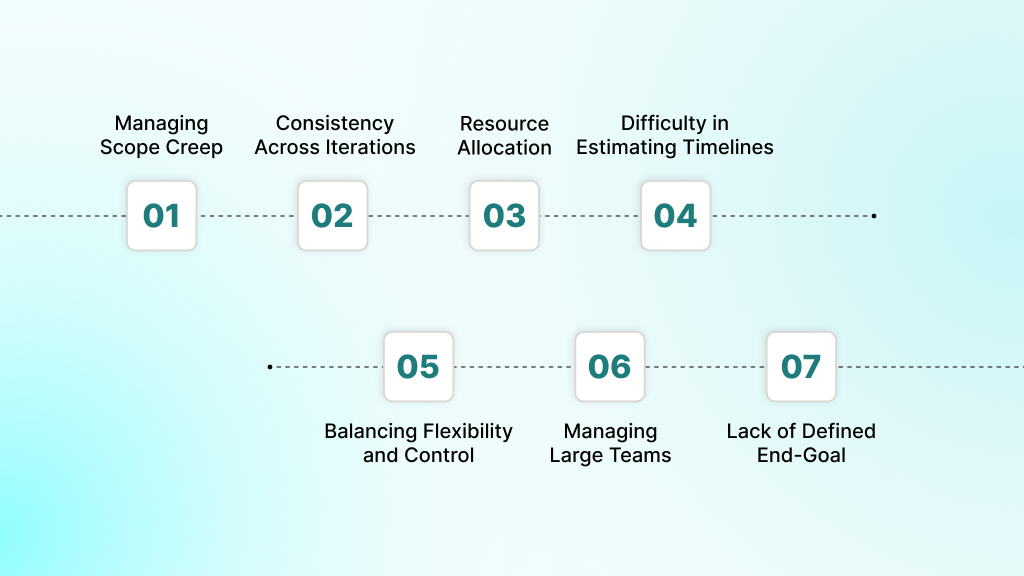
Adaptive Software Development (ASD) is valued for its flexibility, iterative approach, and strong focus on collaboration. These qualities make it well-suited for many projects, but ASD does come with its own set of challenges.
By understanding these challenges and applying practical strategies to tackle them, teams can make the most of what ASD has to offer. Below are the main challenges in ASD and ways to address them effectively.
Managing Scope Creep
One of the most common issues in ASD is scope creep. This happens when the project gradually expands as new requirements keep getting added or existing ones keep changing.
Since ASD encourages flexibility, there is a risk that new features or changes will keep being added, which can lead to missed deadlines and higher costs. To solve this:
- Set Clear Objectives: Even in an adaptive framework, it is important to define clear goals and project boundaries from the start. A well-defined vision helps prevent constant shifts in direction.
- Prioritize Features: Use methods like MoSCoW (Must have, Should have, Could have, Won’t have) to rank features and ensure only essential changes are included in each iteration.
- Regular Stakeholder Reviews: Schedule frequent reviews with stakeholders to stay aligned and prevent unnecessary additions that could disrupt the timeline or budget.
Maintaining Consistency Across Iterations
Since ASD is iterative and often involves multiple teams working on various parts of a project, maintaining regularity in design, functionality, and user experience can be tough. To solve this:
- Standardized Design Principles: Establish consistent design and coding standards for the entire team to follow.
- Frequent Testing: Conduct continuous testing throughout each iteration to catch inconsistencies early. Automated testing tools can help maintain quality.
- Centralized Documentation: While ASD keeps documentation minimal, having a central repository for key design decisions, coding practices, and user requirements ensures the team stays aligned.
Resource Allocation and Overuse
Frequent iteration cycles demand dedicated teams for each phase, which can strain resources, especially in smaller teams or organizations with limited staff. To solve this:
- Effective Resource Planning: Assign team members to phases where their expertise is most needed. Cross-functional teams can bring diverse skills without overloading individuals.
- Outsource or Bring in Specialists: For tasks like UI/UX design or testing, consider external consultants or temporary specialists to support the core team.
- Balance Project Scope: Break the project into smaller, manageable tasks and regularly assess progress to avoid bottlenecks and overuse of resources.
Difficulty in Estimating Timelines and Costs
The flexible, iterative nature of ASD makes it hard to predict timelines and costs, as the number of iterations or new features required may vary. To solve this:
- Set Milestones and Deadlines: Break the project into smaller milestones with realistic deadlines for each iteration.
- Use Historical Data: Past projects can serve as benchmarks for estimating timelines and effort.
- Flexible Budgeting: Build a flexible budget that accounts for changes and includes a contingency for unforeseen issues.
Balancing Flexibility and Control
While flexibility is a key strength, too much of it can lead to a lack of control. Teams may focus on short-term changes without considering long-term goals, which can cause scope expansion or misalignment with business objectives. To solve this:
- Governance Frameworks: Establish a governance structure to provide oversight while maintaining flexibility. Regular check-ins and project reviews ensure changes are justified.
- Clear Roles and Responsibilities: Define roles clearly, with a product owner or project manager maintaining the overall vision and priorities.
- Frequent Communication: Keep open lines of communication across all teams and stakeholders to ensure changes align with broader goals.
Managing Large Teams in Adaptive Development
As projects grow, managing larger teams becomes more complex. Miscommunication, lack of coordination, and differing interpretations of requirements can slow progress. To solve this:
- Agile Team Structures: Break large teams into smaller, cross-functional sub-teams focusing on specific tasks or features for better communication and faster decisions.
- Use Collaboration Tools: Tools like Slack, Jira, or Confluence help teams stay aligned, share documents, and track progress in real-time.
- Leadership and Coordination: Assign team leads for each sub-team or iteration to facilitate communication and ensure alignment with project goals.
Lack of Defined End-Goal
Because ASD is flexible, it can sometimes lack a clearly defined end-goal, causing uncertainty about project direction when stakeholders or team members are not aligned. To solve this:
- Clear Vision and Goal Setting: Establish a high-level vision and strategic goals at the start to keep the team focused.
- Iterative Alignment: Revisit the original objectives with each iteration and hold regular stakeholder check-ins to maintain clarity.
- Long-Term Planning with Short-Term Adjustments: Set long-term goals but remain open to short-term changes based on feedback. Balancing long-term vision with adaptive adjustments keeps the project aligned with business priorities.
Striking the correct balance between long-term vision and short-term adaptation leads naturally to the best practices for implementing ASD.
Also Read: Top Software Development Methodologies Explained
Best Practices for Implementing Adaptive Software Development
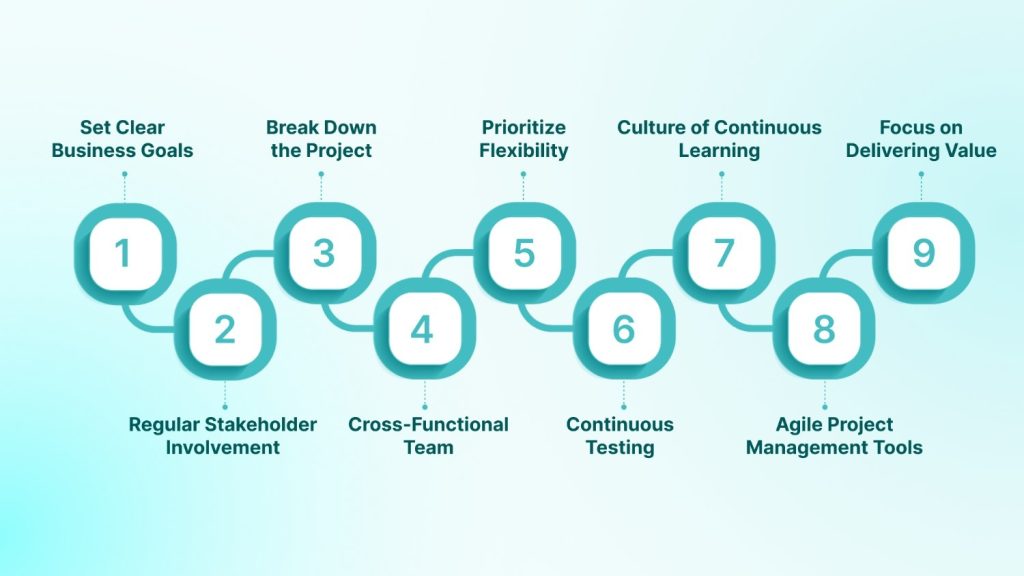
Implementing Adaptive Software Development (ASD) takes thoughtful planning, clear communication, and a commitment to flexibility and iterative work. To get the most out of ASD, businesses should follow best practices that promote collaboration, maintain quality, and keep the development process aligned with changing requirements.
Here are some key best practices for successfully implementing ASD:
Set Clear Business Goals and Objectives
While ASD is focused on flexibility, start with a clear understanding of the overall business goals. These goals will be the guiding framework for all decisions made throughout the development process.
Work with stakeholders to define measurable business objectives that align with the software’s intended purpose. Ensure that these objectives are revisited during each iteration to stay on track.
Emphasize Regular Stakeholder Involvement
Hold frequent review meetings at the end of each iteration to gather feedback and ensure the software is heading in the right direction. Involve both technical and non-technical stakeholders to get a holistic view of progress.
Break Down the Project into Smaller Increments
ASD works best when the project is broken down into manageable, iterative cycles. Each iteration should result in a functional piece of software that can be tested and reviewed.
Start with a minimum viable product (MVP) that includes the most essential features, then build upon it incrementally based on feedback and business priorities. Avoid overloading the first iteration with non-essential features.
Maintain a Collaborative and Cross-Functional Team
Encourage daily stand-ups or quick collaboration sessions where team members can review their progress, address challenges, and discuss next steps. This helps keep the iteration moving forward smoothly.
Prioritize Flexibility Over Detailed Documentation
One of the key advantages of ASD is its adaptability. Rather than spending excessive time on upfront planning and documentation, focus on producing working software and adjusting as you go.
Create just-in-time documentation that supports development and addresses immediate needs rather than extensive planning documents. Keep the documentation lightweight and focused on key decisions and features.
Incorporate Continuous Testing
Implement automated testing to simplify and speed up the testing process. Each time a new iteration is delivered, the automated tests can run to ensure that no critical issues have been introduced and that the software is still aligned with requirements.
Encourage a Culture of Continuous Learning
Since ASD involves ongoing feedback and adjustments, creating a culture of continuous learning is essential. Teams should be encouraged to reflect on each iteration, learn from their successes and mistakes, and improve their processes.
Implement retrospectives after each iteration to discuss what worked well, what did not, and how processes can be improved. Make sure lessons learned are documented and applied to future iterations.
Use Agile Project Management Tools
To effectively manage iterative cycles, collaboration, and project timelines, using an agile project management tool is essential.
Use Kanban boards or Scrum boards to visualize progress and identify bottlenecks. Tools like Jira can also help manage sprints, track issues, and facilitate communication within the team.
Focus on Delivering Value, Not Perfection
In ASD, the goal is to deliver software that is functional and valuable. Each cycle should focus on delivering value to the business, even if it means releasing software that is not perfect.
Use minimum viable product (MVP) principles to focus on delivering the most important features first. As you collect feedback and learn from each iteration, continuously refine the product to increase its value.
Wrapping Up
Adaptive Software Development gives businesses a flexible way to handle the challenges of modern software projects. By focusing on adaptability, continuous feedback, and iterative progress, ASD helps teams stay responsive to change, collaborate more effectively, and deliver high-quality software.
Adopting ASD can change how your teams approach development, making sure projects evolve in step with real-world needs. In a business space where agility and innovation are critical, ASD provides the framework to stay ahead and succeed in the tech market.
Need expert guidance on implementing Adaptive Software Development? DEVtrust is here to help. Our team of skilled developers specializes in ASD and agile methodologies, ensuring your software evolves with your business.
Contact us today to discuss your project and start building flexible, scalable solutions for your business!
Adaptive Software Development Explained: Guide & Key Insights
Learn about Adaptive Software Development, its history, lifecycle, strengths, challenges, and best practices for successful implementation.
Contact Us